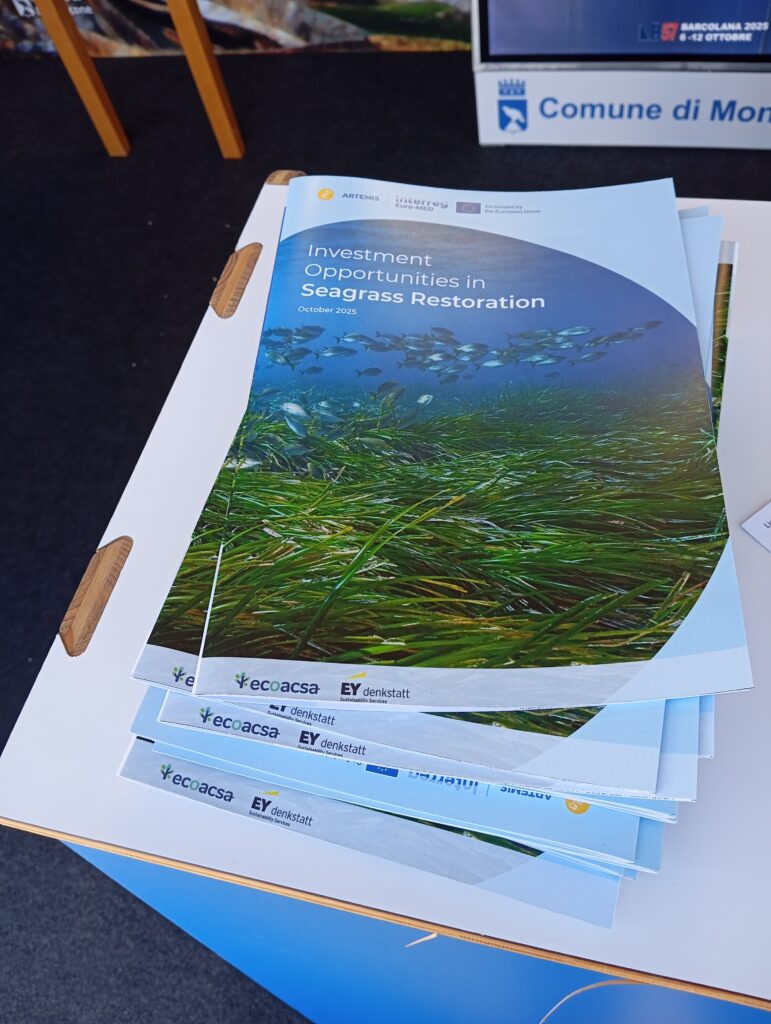The first-ever report dedicated to investment opportunities in seagrass restoration has just been published within the Interreg Euro-MED ARTEMIS project.
Officially presented at the Barcolana Trieste regatta and during the ARTEMIS partners’ meeting in Monfalcone, the publication curated by Ecoacsa and EY Denkstatt Bulgaria, explores how market-based instruments such as Blue Carbon Credits, Biodiversity Credits, and Payment for Ecosystem Services (PES) can finance the recovery and conservation of Posidonia oceanica meadows — one of the Mediterranean’s most valuable yet under-recognised ecosystems.

Why it matters
Mediterranean seagrass meadows, covering about 35,000 km², act as the blue heart of the region — regulating climate, storing carbon, protecting coasts, enhancing fisheries, and supporting tourism. According to France’s national valuation study (2024), each hectare of Posidonia oceanica delivers €86,000 per year in ecosystem services, while globally seagrasses provide an estimated €5.57 trillion in value annually.
Yet these meadows are disappearing at alarming rates: up to 7 % of habitat lost every year. This degradation represents not only an ecological crisis but also a financial risk for coastal economies, insurers, and tourism operators.
Key findings from the report
-
Funding gap: Annual conservation needs for Mediterranean Posidonia amount to €336 million, but current spending is only €17 million — leaving a €319 million gap each year.
-
Economic opportunity: The report identifies a potential seagrass market exceeding €1.3 billion by 2050, as restoration credits become part of blue finance portfolios.
-
Restoration costs: Active restoration ranges between €516,000 – €942,000 per hectare, with pilot cases in the Balearic Islands reaching up to €2.5 million per ha.
-
Investment tools: ARTEMIS promotes a blended-finance model combining public, private, and philanthropic capital to generate verified Blue Carbon and Biodiversity Credits.
-
Pilot sites: Four Mediterranean living labs — Menorca (Spain), Capo Testa – Punta Falcone (Sardinia), Atzikiari Bay (Crete), and Monfalcone (Gulf of Trieste) — are testing scalable models for measurable restoration outcomes.
-
Growth outlook: Credit prices for seagrass restoration could rise from €34,000 to €41,000 per hectare between 2035 and 2050, with active restoration expected to dominate over 60 % of total market value.
The report positions ARTEMIS as a blueprint for investable natural capital, aligning with global and EU frameworks including the Kunming–Montreal Global Biodiversity Framework, EU Nature Restoration Law, CSRD Directive, EU Taxonomy, and Nature Credit Roadmap.
By connecting ecological data with financial valuation through the UN System of Environmental-Economic Accounting (SEEA-EA) and robust Monitoring, Reporting and Verification (MRV) systems, ARTEMIS sets the foundation for credible, bankable marine restoration.
A strategic business opportunity
Investing in seagrass restoration is not philanthropy — it’s a strategic move to:
-
generate financial returns via blue carbon and biodiversity markets;
-
reduce coastal and climate-related risks;
-
meet ESG and CSRD requirements;
-
support resilient tourism, fisheries, and local communities;
-
gain early-mover advantage in the emerging blue economy.
Download the report
Investment Opportunities in Seagrass Restoration – Full Report (October 2025)
Developed by Ecoacsa & EY Denkstatt Bulgaria with the contribution of all ARTEMIS partners.


